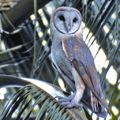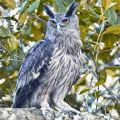Owl
Owl (pencha) nocturnal birds of prey belonging to the order Strigiformes. Owls have large heads, flattened face, rounded tails, and broad wings, the feathers of which are modified for silent flight. The 17 species of barn owl (family Tytonidae) have bare heart-shaped faces and asymmetrical ears to give stereophonic hearing and so facilitate the location of prey; the tail is shorter than the legs.
-
Barn Owl
-
Eagle Owl
-
Fish Owl
-
Asian Barred Owl
The 160 or so species of true or typical owls (family Strigidae) have tails longer than the legs, and many have ear tufts. The powerful, hooked bill is used together with talons to capture and hold prey. The female of most owl species is larger than the male. They have virtually noiseless flight; the butterfly-like flapping of wings is muffled by downy-fringed plumage. These seemingly neckless birds vary in length from 12-14 cm in one of the pygmy owls (Glaucidium minutissimum) to more than 70 cm in the Eurasian Eagle owl (Bubo bubo). The ear openings, hidden by bristlelike hairs, are large, with well-developed and often asymmetrical folds of skin, so that the right and left ears may be differently shaped. Some species have hornlike tufts near the ears.
Owls gather more light in dim nocturnal illumination, enabling these predators to see better in the dark. The orbs are directed forward giving owls binocular vision; they are thus able to perceive the whereabouts of their prey in a three-dimensional manner. Their eyes absorb light to such an extent that most owls are quite uncomfortable in broad daylight. They become dazzled by bright light despite this fact there are some owls that are diurnal. The remarkable barn owls (Tyto species), with rather small eyes, have the most exceptional hearing. They are able to catch prey in total darkness, guided by sound alone. They and several other owls have facial masks to catch sound. Either the external feathering or the skull itself is modified so that sounds reach one ear at a slightly different time to the other; by turning its head the owl can locate the source of a low sound, such as a mouse chewing grain, very precisely.
Most of the owls live on small mammals and small birds which they kill after the manner of hawks. Owls drop down from a perch to catch mammals (from mice to hares, depending upon the size of the owl) or insects on the ground. They also snatch insects from foliage, and large species grab arboreal mammals while smaller species hawk insects in the air. They catch prey with their feet and may reach down and dispatch it with a few bites. Small prey is often lifted to the bill with one foot, in the manner of a parrot; it is swallowed whole. Large prey is held in the feet and dissected with the bill.
Typically, owls are solitary. Since they are more often heard than seen, it is not surprising that many of these birds are named for the calls they make. All owls call, especially as the breeding season approaches. They have a variety of shrieks, hoots, and barks, which are typical of individual species. Several owls sing quite musically. Because of the ominous hooting sounds of their calls and mysterious nocturnal habits, they have been the basis for much superstition, from shrieking ghosts to the ancient belief; thus owls became associated in the mind of man with the occult and the otherworldly. They became symbolic of intelligence because it was thought they presaged events. One species, the barn owl of Europe (Tyto alba), was looked upon as a bird of ill omen, and subsequently became a symbol of disgrace. In the middle ages the common little owl of Europe was used as a symbol of the 'darkness' that was prevalent before the coming of Christ; by further extension it was used to symbolize the nonbelievers who preferred to dwell in this 'darkness'.
Owls are cosmopolitan in distribution and occur on all continents except Antarctica, and are absent from some oceanic islands. Bangladesh has 15 species of owls (family Tytonidae: 1 species; family Strigidae: 14 species), of which 3 are endangered, one is vulnerable; seven could not be evaluated due to paucity of data.
Brown Fish Owl (bhutum pencha) a large nocturnal endangered brown owl (Ketupa zeylonensis, previously known as Bubo zeylonensis), of the family Strigidae, order Strigiformes; streaked all over by black; throat and foreneck whitish. Underparts whitish (pale fulvous) with fine wavy brown cross-bars. Feathers on the head form ear-like structures. The eyes are golden yellow, legs are naked. Body length about 56 cm. They feed on fish, frogs, crabs, small mammals, birds, and reptiles; occasionally carrion. The nesting season ranges from December to March, makes nest in a natural tree-hole, occasionally lined with twigs. Eggs 1 or 2, white. The species lives in well-wooded, well-watered areas and in densely foliaged trees along forest streams and tanks; commonly close to human habitation of the SE, Central and NW areas of Bangladesh. Habitat loss is the main threat to this bird. Bhutum Pencha is also found in Pakistan, India, Nepal, and Bhutan. [Md Anwarul Islam]




